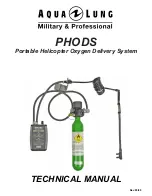
Navigator 600 Silica
Single-stream
Appendix C – Troubleshooting
74
IM/NAV6S/SS–EN Rev. E
Appendix C – Troubleshooting
C.1 Analyzer Malfunction
For the analyzer to function correctly and to specification, the
following conditions must be met:
The correct reagents and calibration solutions must be
connected.
The order that the reagents are introduced into the
reaction block must be correct.
The flowrate of all solutions must be correct.
The analyzer's electronics (transmitter and optical
measuring device) must be functioning correctly.
Virtually all problems with the analyzer are as a result of 1 or
more of these not being correct. For troubleshooting it is
important to remember the basic analyzer functionality with
respect to the 4 conditions above.
C.2 Calibration Errors and Noisy or Incorrect Readings
Symptom
Action
Failing calibration
(calibration
parameters
consistent from one
calibration to the
next)
Check the system for visible air bubbles – see Section C.2.1, page 75
Check that reagents enter the reaction block in the correct order – see Section C.2.3, page 77
Check reagents are correct – see Section C.2.3, page 77
Check solution flowrates – see Section C.2.3, page 77
Check operation of zero and secondary calibration valves – see Section C.2.4, page 78
Check mV values from the optical system – see Section C.2.2, page 76
Failing calibration
(calibration
parameters vary from
one calibration to the
next)
Perform a
Noisy readings
check – see below
Check operation of zero and secondary calibration valves – see Section C.2.4, page 78
Note.
If a zero calibration is carried out on a sample with very high silica levels, the zero offset is
affected; this can result in low value samples reading zero or lower than expected.
Check mV values from the optical system – see Section C.2.2, page 76
Incorrect readings
(Calibrations pass
with consistent
results)
Check the functionality of the Cleaning and Secondary calibration valve:
1. Disconnect the cleaning solution tube from the clean valve manifold and check if the reading
changes after 30 minutes to 1 hour. If it does, the problem is likely to be a leaking clean valve.
Replace the valve (see Appendix H, page 87 – part number AW600034).
2. Disconnect the secondary calibration solution tube from the calibration valve manifold and check if
the reading changes after 30 minutes to 1 hour. If it does, the problem is likely to be a leaking
calibration valve. Replace the valve (see Appendix H, page 87 – part number AW600034).
If no problems can be found, it suggests that the laboratory method could be inaccurate.
Noisy / unstable
readings
Check the system for visible air bubbles – see Section C.2.1, page 75
Check mV values from the optical system for stability – see Section C.2.2, page 76
















































